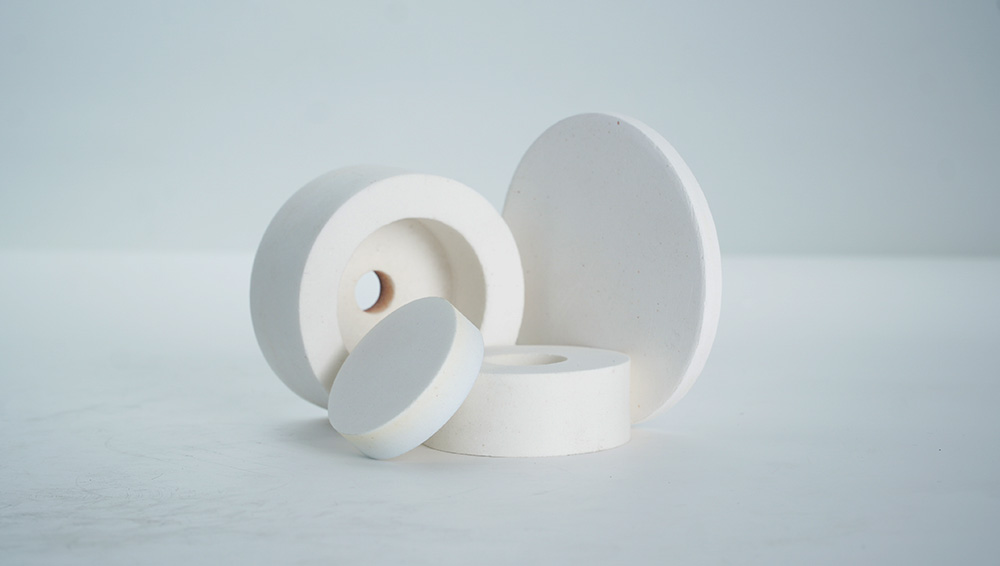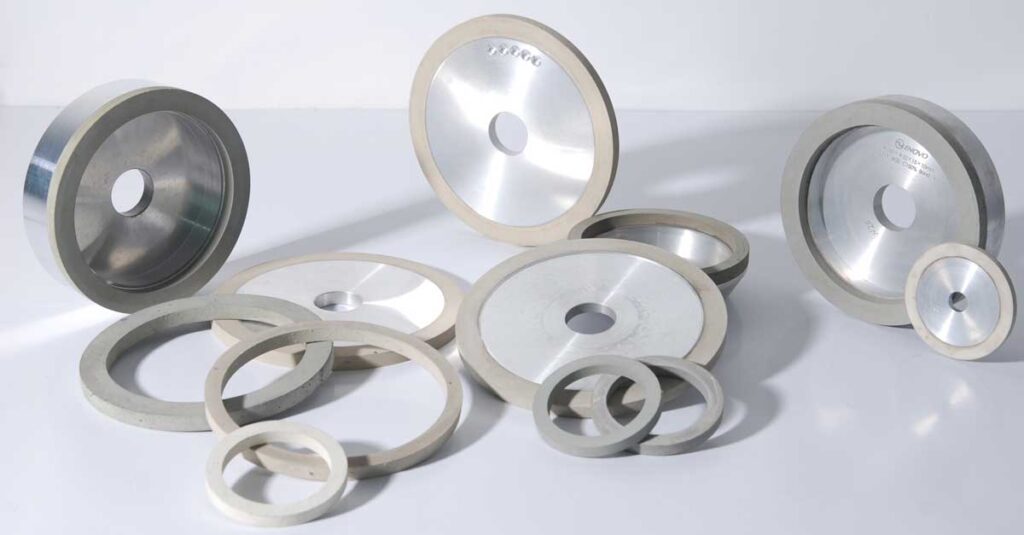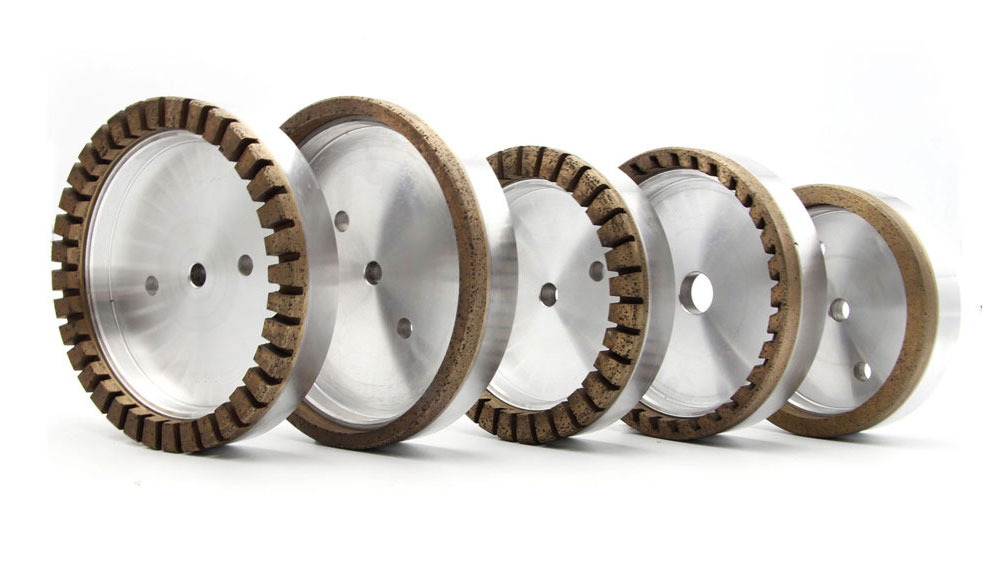
TABLE OF CONTENTS
- Abrasive Material
- Bonding Agent
- Wheel Structure
- Grain Size and Distribution
- Operating Conditions: Finding the Grinding Sweet Spot
- Wheel Maintenance and Dressing
- Application Specifics
- Quality Control and Standards
- Conclusion
Grinding wheels are the workhorses of many industrial applications, but like any tool, they need proper care to last. Let’s explore the key factors that influence a grinding wheel’s lifespan, helping you select the right wheel, use it effectively, and get the most out of your investment. From the type of abrasive material to routine maintenance, learn how to optimize grinding wheel performance and keep your operations running smoothly.
ABRASIVE MATERIAL
The tiny, sharp particles that do the actual grinding are called the abrasive material. The type of abrasive material you choose has a big impact on how long your grinding wheel lasts. Here’s a breakdown of some common abrasives and how they affect wheel life:
ALUMINUM OXIDE (AL2O3)

This is a very versatile and cost-effective abrasive. It’s moderately hard and good for grinding a wide range of materials, including mild steel, stainless steel, and wood. Aluminum oxide breaks down at a predictable rate, which means the wheel will wear steadily and provide a consistent grinding action throughout its life.
SILICON CARBIDE (SIC)
![]()
This is a harder and sharper abrasive than aluminum oxide. It’s a good choice for tougher materials like tool steel, cast iron, and hard stones. However, because it’s sharper, silicon carbide also tends to wear down faster. This means you might need to replace the wheel more often, but the trade-off is a faster grinding rate.
DIAMOND AND CUBIC BORON NITRIDE (CBN)
These are the ultimate in grinding abrasives. They are extremely hard and wear-resistant, making them ideal for very hard materials like carbide, ceramics, and gemstones. Diamond and CBN wheels can last significantly longer than other types, but they are also the most expensive.
Here’s the key takeaway: The hardness and durability of the abrasive material play a big role in wheel life. A harder abrasive will generally last longer, but it might also be more expensive and grind slower. The best choice for you will depend on the specific material you’re grinding and how much you prioritize factors like cost and grinding speed.
BONDING AGENT
It acts like glue, securing the abrasive particles in the wheel and keeping them from breaking away prematurely. The type of bonding agent you choose also significantly impacts the lifespan of your grinding wheel. Here are the most common types of bonding agents and how they affect wheel life:
VITRIFIED BOND

This is a ceramic-like bond made from glass. It’s very strong and durable, making it a good choice for heavy grinding applications. Vitrified bonds hold the abrasive particles very tightly, which means the wheel will wear down slowly. However, a downside is that vitrified bonds can be brittle and susceptible to cracking if subjected to sudden impacts.
RESIN BOND
This is a synthetic bond made from plastic resins. It’s more flexible than vitrified bond and can be formulated for different levels of strength. Resin bonds are often used in wheels for lighter grinding applications or for achieving a finer finish. While they can provide good wheel life, they tend to break down faster at higher temperatures.
METAL BOND

This type of bond is made from metal, such as brass or bronze. It’s very strong and can withstand high temperatures. Metal bonds are often used in grinding wheels for very demanding applications or for grinding materials that generate a lot of heat. The downside is that metal bonds can dull the abrasive particles more quickly, which can reduce the wheel’s grinding efficiency.
Choosing the right bonding agent is a balancing act. You want a bond that’s strong enough to hold the abrasive particles for the duration of the grinding operation, but not so strong that it dulls the cutting edges too quickly. Additionally, you need to consider the operating conditions, such as temperature, when selecting a bond type.
WHEEL STRUCTURE
The way the abrasive particles and bonding agent are arranged within the wheel is called the structure. This might seem like a minor detail, but it actually has a big impact on how long your grinding wheel will last. There are two main types of wheel structures:
OPEN STRUCTURE
In an open structure wheel, there are more voids or air spaces between the abrasive particles. This allows for better chip clearance, which means the small pieces of material removed during grinding can escape more easily. This is important because clogged wheels can overheat and wear down faster. The open structure also allows for cooler operation, which helps to extend wheel life, especially for tasks that generate a lot of heat. However, the downside of an open structure is that the abrasive particles are not held as tightly, which can lead to faster wear on softer abrasives.
DENSE STRUCTURE
In a dense structure wheel, there are fewer voids between the abrasive particles. This creates a stronger and more durable wheel that can withstand higher grinding pressures. Dense wheels are also a good choice for achieving a finer finish. However, the downside is that the limited space for chip clearance can lead to clogging and overheating, which can shorten wheel life.
The best structure for you depends on your grinding application. If chip clearance and heat dissipation are major concerns, an open structure might be a better choice. If you prioritize a strong wheel for heavy grinding or a fine finish, a denser structure might be preferable.
GRAIN SIZE AND DISTRIBUTION

The size of the abrasive particles in the grinding wheel is called the grain size. This plays a crucial role in both grinding efficiency and wheel life. Here’s how:
- Coarse Grain: Wheels with coarse grain particles have larger and fewer abrasive points. This allows for faster material removal, which can be beneficial for rough grinding applications. However, the downside is that coarse grains tend to leave a rougher finish and can wear down the wheel faster because the individual abrasive points wear out quicker.
- Fine Grain: Wheels with fine grain particles have smaller and more numerous abrasive points. This allows for a smoother finish but with a slower material removal rate. Fine grain wheels tend to last longer because there are more abrasive points to wear down before the wheel loses its effectiveness.
Grain distribution refers to how evenly the abrasive particles are spread throughout the wheel. Uneven distribution can lead to inconsistent grinding performance and premature wheel wear. A high-quality grinding wheel will have a uniform distribution of abrasive particles for optimal performance and extended lifespan.
OPERATING CONDITIONS: FINDING THE GRINDING SWEET SPOT
How you use your grinding wheel can significantly impact its lifespan. Here are some key operating conditions to consider:
SPEED
Generally, grinding at excessively high speeds can lead to faster wheel wear. This is because the increased friction generates more heat, which can break down the bonding agent and dull the abrasive particles. However, grinding too slowly can also be inefficient. There’s an optimal speed range for each grinding application that balances material removal rate with wheel life.
PRESSURE
The amount of pressure you apply to the workpiece during grinding also affects wheel wear. Excessive pressure can overload the abrasive particles, causing them to fracture and wear down more quickly. On the other hand, too little pressure might not be effective in removing material. Finding the right balance between pressure and grinding speed is crucial for maximizing wheel life and achieving the desired results.
COOLANT USAGE
Using a coolant during grinding is essential for several reasons, and one of them is wheel life. Coolant helps to reduce heat buildup, which can extend the life of the bonding agent and abrasive particles. It also helps to wash away chips and debris, preventing clogging that can lead to overheating and premature wear.
By understanding how these operating conditions affect wheel wear, you can adjust your grinding practices to optimize wheel life and maintain performance. Many grinding machines have adjustable speed and pressure settings, and using a coolant appropriate for the material you’re grinding is crucial.
WHEEL MAINTENANCE AND DRESSING
![]()
Just like any tool, grinding wheels require regular maintenance to ensure optimal performance and lifespan. Here are two key aspects of grinding wheel maintenance:
- Cleaning: Over time, the grinding wheel can become clogged with metal chips and debris. This can hinder grinding performance and lead to overheating. Regular cleaning with a wire brush or a dedicated wheel cleaner helps to remove these contaminants and maintain proper chip clearance.
- Dressing: As the abrasive particles wear down during grinding, the wheel’s cutting ability diminishes. Wheel dressing is a process that uses a dressing tool, like a diamond wheel dresser, to true the grinding surface and expose fresh abrasive particles. Regular dressing restores the wheel’s cutting efficiency and extends its usable life. There are different dressing techniques depending on the type of wheel and the desired grinding profile.
Following a proper maintenance routine that includes cleaning and dressing will help you get the most out of your grinding wheel and ensure consistent performance throughout its lifespan.
APPLICATION SPECIFICS
Different grinding applications have different requirements. For example, surface grinding requires a wheel that can achieve a flat and smooth finish, while cylindrical grinding might prioritize fast material removal for shaping a round workpiece. Choosing the right grinding wheel for the specific application is crucial for both efficiency and wheel life.
Here’s how application requirements impact wheel selection and durability:
GRINDING PROCESS
The type of grinding process, such as surface grinding, cylindrical grinding, or internal grinding, will dictate the wheel shape, size, and bond type needed for optimal performance. For example, a surface grinding wheel will typically be wider and flatter than a cylindrical grinding wheel.
WORKPIECE MATERIAL
The material you’re grinding also plays a role. As discussed earlier, harder materials require a harder and sharper abrasive like silicon carbide or CBN, while softer materials might work well with aluminum oxide. The choice of abrasive material and bond type will influence the wheel’s durability for the specific application.
Selecting a grinding wheel that’s specifically designed for your application will not only ensure you achieve the desired results, but it will also help you maximize wheel life by using the appropriate abrasive material, bond type, and structure for the grinding task.
QUALITY CONTROL AND STANDARDS
Grinding wheels can be powerful tools, but they also need to be safe. That’s why there are industry standards and regulations in place to ensure the quality and safety of grinding wheels. These standards address factors like:
MATERIAL COMPOSITION
Standards specify the type and quality of abrasive materials and bonding agents that can be used in grinding wheels. This helps to ensure that the wheels are strong enough for their intended applications and will not shatter or break apart during use.
MANUFACTURING PROCESSES
Grinding wheel manufacturers must adhere to strict quality control measures during the production process. This includes inspections of raw materials, monitoring of manufacturing parameters, and final testing of the finished wheels to ensure they meet safety and performance standards.
BALANCE
A grinding wheel that is out of balance can vibrate excessively during use, which can lead to safety hazards and reduced grinding performance. Standards require grinding wheels to be properly balanced to ensure smooth operation.
By following these quality control measures and adhering to industry standards, grinding wheel manufacturers can help to ensure that their products are safe, reliable, and have a long lifespan.
Conclusion
Understanding these factors is key to maximizing the efficiency and lifespan of your grinding wheels. By making informed choices about wheel selection, operating practices, and maintenance routines, you can get the most out of your grinding investment and keep your operations running smoothly. Moreover, an inappropriate proportion of the grains can result in the wear of just particular areas and the imperfection in other areas and subsequently ultimately the destruction of the wheel.
